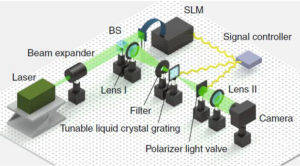A team of researchers led by Yi-Long Li of the School of Instrumentation and Optoelectronic Engineering, Beihang University (Beijing, China) is developing a holographic display system that presents an image with a wider viewing angle and an enlarged size compared to systems based on more conventional approaches.
A specific example of the image produced by one of the main types of conventional holographic display systems, one based on a single spatial light modulator (SLM), has a viewing angle of less than 9 degrees and a size less than 2 cm. Improving the viewing angle and size of the image produced by such a holographic display system was the subject of the research undertaken by the team.
The team’s new approach was based on the simultaneous implementation of two different hologram generation methods. The first was a tunable liquid crystal grating with an adjustable period that served to widen the viewing angle. The second was the secondary diffraction of the reconstructed image to increase the image size.
A recent article by the team on this topic is entitled “Tunable liquid crystal grating based holographic 3D display system with wide viewing angle and large size.” It was published in Light: Science & Applications (2022) 11:188. A copy of the article is available on-line and can be found on Nature.

To achieve a wide viewing angle, the researchers applied a voltage to the liquid crystal grating. Doing so causes the liquid crystal molecules to assume a periodic order forming a diffraction grating. The grating, in turn, causes the formation of secondary diffraction images. The number of secondary diffraction images could be adjusted by varying the voltage applied to the liquid crystal grating device and tuning the periodicity of the grating. Adjustments to the polarized light valve were used to ensure that only positive, first order diffracted light could pass through the system.
“To enlarge the size of the image, the researchers generated a hologram of the 3D object and divided it into two subholograms that were of equal size. The first subhologram was loaded on the SLM before voltage was applied to the grating. The second subhologram was then loaded on the SLM while voltage was being applied. This generated a zero order primary maximum and ±1 order secondary maximums on the spectral plane.”
The researchers developed a system to control the switching speed of the hologram and the tuning of the liquid crystal grating. “When the switching time became sufficiently fast, the reconstructed images of subhologram 1 and subhologram 2 could be spliced seamlessly in space to create a large size holographic display that is aligned with the visual persistence effect of the human eye.” This effect was indeed possible because the response time of the grating was 29.2 ms, which met the requirements for synchronous control. This switching principle is illustrated in the figure below.

In experiments, the holographic display system demonstrated a viewing angle of 57.4 degrees, which is 7 times that of a conventional system using a single SLM. The system demonstrated that it could magnify the size of an image by a factor of 4.2.
In addition to holographic displays, the team expects the newly developed display system to have applicability for augmented reality displays.

